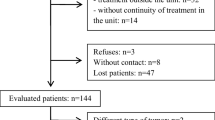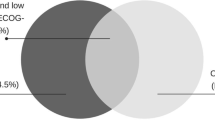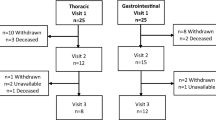Abstract
Purpose
Handgrip strength (HGS) has been shown to predict survival and is associated with changes in body composition, nutritional status, inflammation, and functional ability in several chronic disease conditions. Whether similar relationships exist between HGS and clinical outcomes in patients with advanced cancer are currently unknown. We evaluated the association between HGS and survival as well as several key markers of body composition (e.g., sarcopenia), subjective performance measures (e.g., quality of life), and muscle strength (e.g., isokinetic torque of the quadriceps) in patients with advanced forms of non-small cell lung and gastrointestinal cancers.
Methods
A consecutive cohort of 203 patients with advanced cancer was enrolled and categorized into three HGS percentiles (e.g., ≥50th, 25th, and ≤10th) according to published normative values. Multivariate regression analyses were used to test for independent associations between HGS and survival, sarcopenia, quality of life (QoL), and lower extremity muscle strength as well as key biological markers (e.g., hemoglobin, albumin, and C-reactive protein) while controlling for age, gender, cancer diagnosis, treatment (chemotherapy/radiotherapy), medications, and time from diagnosis to assessment.
Results
When compared to HGS ≥50th, patients in the HGS ≤10th percentile had lower BMI (B, −2.5 kg/m2; 95% CI, −4.5 to −0.45), shorter survival (hazard ratio, 3.2; 2.0–5.1), lower hemoglobin (−19.70 g/L; −27.28 to −12.13) and albumin (−4.99 g/L; −7.85 to −2.13), greater occurrence of sarcopenia (odds ratio, 9.53; 1.95–46.55), lower isokinetic torque of the quadriceps at both 60°/s (−30.6 Nm; −57.9 to −3.3) and 120°/s (−25.1 Nm; −46.4 to −3.7), lower QoL (−1.6 on McGill Quality of Life Questionnaire scale; −2.5 to −0.6), higher levels of fatigue (18.8 on Brief Fatigue Inventory scale; 4.7 –32.9), poorer performance status (0.75 on Eastern Cooperative Oncology Group Performance Status scale; 0.34–1.15), lower fat mass (−7.4 kg; −14.4 to −0.5), and lower lean body mass (−6.5 kg; −10.3 to −2.8).
Conclusions
HGS is independently associated with survival and important biological, functional, and quality of life characteristics in advanced cancer patients. Patients presenting with very low percentiles with respect to their handgrip assessment may require timely referral to supportive and/or palliative care services.

Similar content being viewed by others
References
Evans WJ, Morley JE, Argiles J, Bales C et al (2008) Cachexia: a new definition. Clin Nutr 27:793–799
Vigano A, Del Fabbro E, Bruera E, Borod M (2012) The Cachexia Clinic: from staging to managing nutritional and functional problems in advanced cancer patients. Crit Rev Oncogenesis 17:293–304
Prado CMM, Liefferes JR, McCargar LJ et al (2008) Prevalence and clinical implications of sarcopenic obesity in patients with solid tumours of the respiratory and gastrointestinal tracts: a population-based study. Lancet Oncol 9:629–635
Rantanen T, Volpato S, Ferrucci L et al (2003) Handgrip strength and cause-specific and total mortality in older disabled women: exploring the mechanism. J Am Geriatr Soc 51:636–641
Trutschnigg B, Kilgour RD, Reinglas J et al (2008) Precision and reliability of strength (Jamar vs. Biodex handgrip) and body composition (dual-energy X-ray absorptiometry vs. bioimpedance analysis) measurements in advanced cancer patients. Appl Physiol Nutr Metab 33:1232–1239
Metter EJ, Talbot LA, Schrager M et al (2002) Skeletal muscle strength as a predictor of all-cause mortality in healthy men. J Gerontol: Biol Sci 57A:B359–B365
Newman AB, Kupelian V, Visser M et al (2006) Strength, but not muscle mass, is associated with mortality in the Health, Aging and Body Composition Study cohort. J Gerontol: Med Sci 61A:72–77
Norman K, Stobäus N, Smoliner C et al (2010) Determinants of hand grip strength, knee extension strength and functional status in cancer patients. Clin Nutr 29:586–591
Burden ST, Hill J, Shaffer JL, Todd C (2010) Nutritional status of preoperative colorectal cancer patients. J Hum Nutr Diet 23:402–407
Wang AY-M, Sea MM-M, Ho ZS-Y et al (2005) Evaluation of handgrip strength as a nutritional marker and prognostic indicator in peritoneal dialysis patients. Am J Clin Nutr 81:79–86
Sasaki H, Kasagi F, Yamada M et al (2007) Grip strength predicts cause-specific mortality in middle-aged and elderly persons. Am J Med 120:337–342
Gale CR, Martyn CN, Cooper C et al (2007) Grip strength, body composition, and mortality. Int J Epidemiol 36:228–235
Chang Y-T, Wu H-L, Guo H-R et al (2011) Handgrip strength is an independent predictor of renal outcomes in patients with chronic kidney diseases. Nephrol Dial Transplant 26:3588–3595
Yoda M, Inaba M, Okuno S et al (2012) Poor muscle quality as a predictor of high mortality independent of diabetes in hemodialysis patients. Biomed Pharmacother 66:266–270
Silva LF, Matos CM, Lopes GB et al (2011) Handgrip strength as a simple indicator of possible malnutrition and inflammation in men and women on maintenance hemodialysis. Journal of Renal Nutr 21:235–245
Leal VO, Stockler-Pinto MP, Farage NE, Aranha LN et al (2011) Handgrip strength and its dialysis determinants in hemodialysis patients. Nutrition 27:1125–1129
Beenakkera K, Linga CH, Meskersb CG, de Craena AJM (2010) Patterns of muscle strength loss with age in the general population and patients with a chronic inflammatory state. Ageing Res Rev 9:431–436
Cheung C-L, Nguyen UDTAE et al (2012) Association of handgrip strength with chronic diseases and multimorbidity. Age. doi:10.1007/s11357-012-9385-y
Bruera E, Kuehn N, Miller MJ et al (1991) The Edmonton Symptom Assessment System (ESAS): a simple method for the assessment of palliative care patients. J Palliat Care 7:6–9
Mathiowetz V, Weber K, Volland G et al (1984) Reliability and validity of grip and pinch strength evaluations. J Hand Surg Am 9:222–226
Rantanen I, Era P, Kauppinen M, Heikkinen E (1994) Maximal isometric muscle strength and socio-economic status, health, and physical activity in 75-year-old persons. J Aging Phys Act 2:206–220
Mathiowetz V (1990) Grip and pinch strength measurements. In: Amundsen LR (ed) Muscle strength testing; instrumented and non-instrumented systems. Churchill Livingstone, New York, pp 163–177
Cleeland CS, Wang XS (1999) Measuring and understanding fatigue. Oncology 13:91–97
Mendoza TR, Wang XS, Cleeland CS et al (1999) The rapid assessment of fatigue severity in cancer patients: use of the Brief Fatigue Inventory. Cancer 85:1186–1196
Cohen SR, Mount BM, Strobel MG et al (1995) The McGill Quality of Life Questionnaire: a measure of quality of life appropriate for people with advanced disease. A preliminary study of validity and acceptability. Palliat Med 9:207–219
Baumgartner RN, Koehler KM, Gallagher D et al (1998) Epidemiology of sarcopenia among the elderly in New Mexico. Am J Epidemiol 147:755–763
Simmonds MJ (2002) Physical function in patients with cancer: psychometric characteristics and clinical usefulness of a physical performance test battery. J Pain Symptom Management 24:404–414
Drouin JM, Valovich-McLeod TC, Shultz SJ et al (2004) Reliability and validity of the Biodex system 3 pro isokinetic dynamometer velocity, torque and position measurements. Eur J Appl Physiol 91:22–29
Symons TB, Vandervoort AA, Rice CL et al (2005) Reliability of a single-session isokinetic and isometric strength measurement protocol in older men. J Gerontol A Biol Sci Med Sci 60:114–119
Weber MA, Krakowski-Roosen H, Schroder L et al (2009) Morphology, metabolism, microcirculation, and strength of skeletal muscles in cancer-related cachexia. Acta Oncol 48:116–124
SPSS Inc. (2005) SPSS 14.0 for Windows. Chicago, IL
Mathiowetz V, Kashman N, Volland G et al (1985) Grip and pinch strength: normative data for adults. Arch Phys Med Rehabil 66:69–74
Valentini L, Schaper L, Buning C et al (2008) Malnutrition and impaired muscle strength in patients with Crohn's disease and ulcerative colitis in remission. Nutrition 24:694–702
Álvares-da-Silva MR, Reverbel da Silveira T (2005) Comparison between handgrip strength, subjective global assessment, and prognostic nutritional index in assessing malnutrition and predicting clinical outcome in cirrhotic outpatients. Nutrition 21:113–117
Ruiz JR, Xue MS, Lobelo F et al (2008) Association between muscular strength and mortality in men: prospective cohort study. BMJ 337:92–95
Xue Q-L, Beamer BA, Chaves PHM et al (2010) Heterogeneity in rate of decline in grip, hip, and knee strength and the risk of all-cause mortality: the Women's Health and Aging Study II. J Am Geriatr Soc 58:2076–2084
Innes E (1999) Handgrip strength testing: a review of literature. Aust Occup Therap J 46:120–140
Stephens NA, Gray C, MacDonald AJ et al (2012) Sexual dimorphism modulates the impact of cancer cachexia on lower limb muscle mass and function. Clin Nutri 31:499–505
Kilgour RD, Vigano A, Trutschnigg B, Hornby L, Lucar E, Bacon SL, Morais JA (2010) Cancer- related fatigue: the impact of skeletal muscle mass and strength in patients with advanced cancer. J Cachexia Sarcopenia Muscle 1:177–185
Jakobsen LH, Rask IK, Kondrup J (2010) Validation of handgrip strength and endurance as a measure of physical function and quality of life in healthy subjects and patients. Nutrition 26:542–550
Norman K, Kirchner H, Freudenreich M et al (2008) Three month intervention with protein and energy rich supplements improve muscle function and quality of life in malnourished patients with non-neoplastic gastrointestinal disease—a randomized controlled trial. Clin Nutr 27:48–56
Fearon K, Strasser F, Anker SD et al (2011) Definition and classification of cancer cachexia: an international consensus. Lancet Oncol 12:489–495
Kisiel-Sajewicz K, Davis MP, Siemionow V et al (2012) Lack of muscle contractile property changes at the time of perceived physical exhaustion suggests central mechanisms contributing to early motor task failure in patients with cancer-related fatigue. J Pain Symp Manag 44:351–361
Disclosures
This work was supported by the Canadian Foundation for Innovation (CFI)-New Opportunities Award (AV), Canadian Institute for Health Research (CIHR)-Operating Grant (AV), McGill University Health Centre Research Institute-Pilot project Competition (AV), Canada Graduate Scholarships-CIHR Master's Award (BT), and the Academic Unit Head Research Fund of Concordia University (RK)
Author information
Authors and Affiliations
Corresponding author
Additional information
This study was presented as a poster at the 2012 MASCC/ISOO International Symposium, New York City, NY, USA on 28–30 June 2012.
Rights and permissions
About this article
Cite this article
Kilgour, R.D., Vigano, A., Trutschnigg, B. et al. Handgrip strength predicts survival and is associated with markers of clinical and functional outcomes in advanced cancer patients. Support Care Cancer 21, 3261–3270 (2013). https://doi.org/10.1007/s00520-013-1894-4
Received:
Accepted:
Published:
Issue Date:
DOI: https://doi.org/10.1007/s00520-013-1894-4




